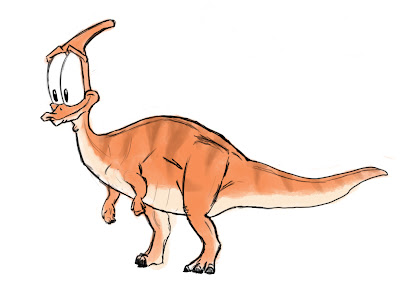Hadrosaurs - or more publicly known as duckbill dinosaurs - have been found in North America, South America, Asia, Europe, and Antarctica. They were the cows of the Cretaceous - large, herding, plant-eating dinosaurs, with mouths full of teeth behind broad beaks! Hadrosaurs were the most advanced types of ornithopods by the late Cretaceous, having evolved into two different groups: Lambeosaurinae and Hadrosaurinae.
Lambeosaurinae hadrosaurs include the hollow-crested and short-beaked Parasauolophus, Olorotita, and Corythosaurus. Hadrosaurs in Hadrosaurinae include the larger and broad-beaked Edmontosaurus, Gryposaurus and Saurolophus. Join us as we celebrate all things Hadrosaurs! Scroll down to view all the beautiful duckbill artwork. Click on the images to enlarge them.
If you wish to participate in the gallery and have your artwork displayed here, send your work to us at artevolved@gmail.com.
Welcome to ART Evolved's Hadrosaur Gallery:
Lambeosaurinae -
Lambeosaurus by Scott Elyard
Downhill by Scott Elyard
Mountain Lambeosaur by Luis Perez
Corythosaur Crossing by Craig Dylke
Tsintaosaurus by Peter Bond
Two Charonosaurus by Julio Lacerda
Cartoon Parasaurolophus Sketch by Evan Boucher
Hatsunesaurus Mikuius by Bruce-Earl Barr
gee... that Parasaurolophus looks vary familiar! I just can’t put my finger on it. Oh well! Hadrosaurs are well known for their “singing” ability so I just had to draw this!
Parasaurolophus in Love by Peter Bond
The Gangsters of Love by Patricia Arnold
Selected Hadrosaur ACEOs by Patricia Arnold
Walk This Way by Santino Mazzei
From the underground we are looking the walk of an adult Hadrosauroid dinosaur with his chick. We can also observe the footprints left from the two animals. Unfortunately, from this point of view we can't determine what kind of species is.
Hadrosaurinae -
Thespesius occidentalis by Matt Martyniuk
A huge bull hadrosaur attempts to frighten off an interloper to his magnolia grove in a Lance Formation forest. The bull is based on specimens usually referred to Anatotitan copei, while the smaller individual is based on the "Trachodon mummy" specimen usually referred to Edmontosaurus/Anatosaurus annectens. The skin texture and inflatable nasal structure are also based on evidence from the "mummy" specimen. All Lancian hadrosaurs are probably growth stages of a
single species, the oldest available name for which is Thespesius occidentalis.
Breaking the Curse II by Albertonykus
The curse of the deinonychosaurs ("raptor" dinosaurs) is this: they are so cool that some people think they can kill anything, or at least any plant-eating dinosaur. We see this in TV programs like Clash of the Dinosaurs and Jurassic Fight Club. I've even seen it in some children's books on dinosaurs. I love deinonychosaurs, too. They are among my favorite dinosaurs, but dinosaurs are real-life animals, not sci-fi monsters. This is especially absurd when we talk about troodonts or basal dromaeosaurids - every inch of their anatomy shows they chased after smaller animals. Troodonts may have even eaten some plants. Eudromaeosaurs (derived dromaeosaurids), including Velociraptor mongoliensis and Deinonychus antirrhopus, may have been able to manage slightly larger prey, especially if they were group hunters, which is debatable. However, this doesn't mean they're going to attack something hundreds of times their size like a half-grown sauropod (giant long-necked plant-eating dinosaur) or a large hadrosaur (duck-billed dinosaur). Yet, there really are media out there that show them doing this, or claim that they're capable of it. No kidding.
Edmontosaurus regalis by Peter Bond
Two Gryposaurs by Ingunn Aasland
This is two Gryposaurus having a bit of a squabble and the medium is ink, pencil, and crayon. I don't recall ever having seen any illustrations of interspecies fighting among hadrosaurs but obviously they did - all animals, even the "harmless" herbivorous prey animals, fight for mating rights, food, or social status.
Bear in mind I'm still just an enthusiastic noob - please, for the love of godzilla, let me know if I make mistakes!
Saurolophus by Peter Bond
Brachylophosaurus by Anthony Contoleon
It's a Brachylophosaurus, based off of a Scott Hartman skeleton reconstruction. I've also included a few inprogress images too.
Five Hadrosaurs by Mo Hassan
Featuring:
top left: Parasaurolophus walkeri with coloration inspired by the hoopoe (Upupa epops)
bottom left: Corythosaurus casuarius with coloration inspired by the southern cassowary (Casuarius casuarius)
top centre: Lambeosaurus magnicristatus with coloration inspired by the mandarin duck (Aix galericulata)
bottom centre: Olorotitan arharensis with coloration inspired by the roseate spoonbill (Platalea ajaja)
right: Saurolophus osborni with coloration inspired by the secretary bird (Sagittarius serpentarius)
Drawn in colour pencil in July 2008.
Nipponosaurus sachalinensis by Mo Hassan
A Russian hadrosaur from the island of Sakhalin, patterned in the colours of the Russian flag. Drawn in colour pencil in July 2010.
Lambeosaurus magnicristatus by Mo Hassan
Flame-coloured lambeosaur which will feature in a new book about unusual dinosaurs aimed at ten-year-olds. Drawn in colour pencil in April 2011.
Anasazisaurus horneri by Luis Perez
Aralosaurus tuberiferus by Luis Perez
Brachylophosaurus canadiensis by Luis Perez
Lambeosaurus by Angie Rodrigues
Edmontosaurus by Vasika Udurawane
Edmontosaurus, with a juvenile Byachychampsa alligator in the forground on a dead dinosaur.
That brings us to the end of May's Hadrosaur Gallery! We hope you like it! If you want to participate and you are a little late, or you have just run across this post and you want to submit, just send in your art to us at artevolved@gmail.com.
After an intense battle between time periods and paleoenvironments, the topic of the next Time Capsule will be the Carboniferous Time Period! This gallery opens July 1st, and as it is the summer, and many of us are on holiday and lounging on the beach, this topic is hopefully an easy one to submit to. If you want to paint a terrestrial amphibian, paint a terrestrial amphibian. If you want to sketch a giant fern tree, sketch a fern tree. If you want to 3D model an arthropod, 3D model an arthropod!
Can't wait to see what the palaeosphere artists come up with this summer! Send in your Carboniferous art to artevolved@gmail.com.

































